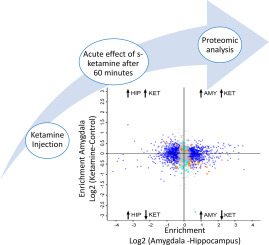当前位置:
X-MOL 学术
›
J. Proteomics
›
论文详情
Our official English website, www.x-mol.net, welcomes your
feedback! (Note: you will need to create a separate account there.)
S-ketamine induces acute changes in the proteome of the mouse amygdala.
Journal of Proteomics ( IF 2.8 ) Pub Date : 2020-02-04 , DOI: 10.1016/j.jprot.2020.103679 Mhd Rami Al Shweiki 1 , Patrick Oeckl 1 , Petra Steinacker 1 , Peggy Barschke 1 , Christopher Pryce 2 , Cornelia Dorner-Ciossek 3 , Carlos Schönfeldt-Lecuona 4 , Bastian Hengerer 3 , Markus Otto 1
Journal of Proteomics ( IF 2.8 ) Pub Date : 2020-02-04 , DOI: 10.1016/j.jprot.2020.103679 Mhd Rami Al Shweiki 1 , Patrick Oeckl 1 , Petra Steinacker 1 , Peggy Barschke 1 , Christopher Pryce 2 , Cornelia Dorner-Ciossek 3 , Carlos Schönfeldt-Lecuona 4 , Bastian Hengerer 3 , Markus Otto 1
Affiliation

|
Current understanding of the molecular mechanisms underlying ketamine's antidepressant effect remains largely incomplete. Recent imaging studies provide evidence for ketamine effects on amygdalo-hippocampal. This study in mice aimed to investigate acute proteomic changes after ketamine administration in various brain regions including amygdala and hippocampus. One hour after administration of s-ketamine, the brain-region tissues of interest were dissected out and analyzed using label-free shotgun proteomics. The deep proteomic analysis of amygdala and hippocampus identified 89,526 peptides corresponding to 8000 proteins. The analysis revealed a pronounced proteomic signature of the acute ketamine effect in the amygdala. We anticipate that this proteomic dataset will improve understanding of the mechanism of action of ketamine and identification of new drug targets. SIGNIFICANCE: Major depressive disorder (MDD) is the leading cause of global disability and it presents a significant challenge to human health. S-ketamine has been proposed as a rapid acting antidepressant and, indeed, the FDA recently approved it for treatment of resistant MDD. However, the mechanism of action of s-ketamine as an antidepressant is still elusive. In this context, we investigated the short-term proteomic changes after ketamine administration in mouse brain regions previously related to ketamine effects such as amygdala and hippocampus. We anticipate that this proteomic dataset will provide highly useful information to improve our understanding of the mechanism of action of ketamine and identification of new drug targets.
中文翻译:

S-氯胺酮诱导小鼠杏仁核蛋白质组中的急性变化。
目前对氯胺酮抗抑郁作用的分子机制的了解仍然不完整。最近的影像学研究为氯胺酮对杏仁核-海马体的作用提供了证据。这项针对小鼠的研究旨在研究氯胺酮给药后在包括杏仁核和海马体在内的各个大脑区域的急性蛋白质组学变化。服用s-氯胺酮1小时后,将感兴趣的大脑区域组织解剖并使用无标记free弹枪蛋白质组学进行分析。对杏仁核和海马的深层蛋白质组学分析确定了89,526个对应于8000种蛋白质的肽。该分析揭示了杏仁核中急性氯胺酮效应的明显蛋白质组学特征。我们预计该蛋白质组学数据集将增进对氯胺酮作用机理的了解和新药靶标的识别。意义:重度抑郁症(MDD)是全球残疾的主要原因,它对人类健康提出了重大挑战。S-氯胺酮已被提议作为一种速效抗抑郁药,实际上,FDA最近批准了它用于治疗耐药性MDD。然而,s-氯胺酮作为抗抑郁药的作用机理仍然难以捉摸。在这种情况下,我们调查了氯胺酮在老鼠大脑区域中与氯胺酮作用(如杏仁核和海马体)相关后的短期蛋白质组学变化。
更新日期:2020-02-06
中文翻译:

S-氯胺酮诱导小鼠杏仁核蛋白质组中的急性变化。
目前对氯胺酮抗抑郁作用的分子机制的了解仍然不完整。最近的影像学研究为氯胺酮对杏仁核-海马体的作用提供了证据。这项针对小鼠的研究旨在研究氯胺酮给药后在包括杏仁核和海马体在内的各个大脑区域的急性蛋白质组学变化。服用s-氯胺酮1小时后,将感兴趣的大脑区域组织解剖并使用无标记free弹枪蛋白质组学进行分析。对杏仁核和海马的深层蛋白质组学分析确定了89,526个对应于8000种蛋白质的肽。该分析揭示了杏仁核中急性氯胺酮效应的明显蛋白质组学特征。我们预计该蛋白质组学数据集将增进对氯胺酮作用机理的了解和新药靶标的识别。意义:重度抑郁症(MDD)是全球残疾的主要原因,它对人类健康提出了重大挑战。S-氯胺酮已被提议作为一种速效抗抑郁药,实际上,FDA最近批准了它用于治疗耐药性MDD。然而,s-氯胺酮作为抗抑郁药的作用机理仍然难以捉摸。在这种情况下,我们调查了氯胺酮在老鼠大脑区域中与氯胺酮作用(如杏仁核和海马体)相关后的短期蛋白质组学变化。











































 京公网安备 11010802027423号
京公网安备 11010802027423号